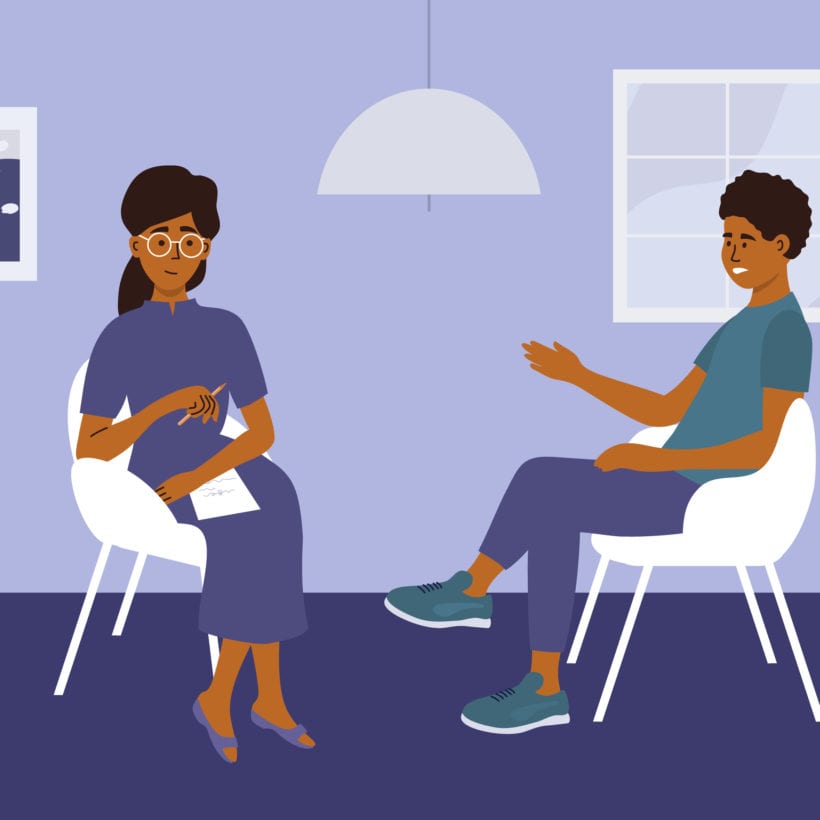Therapy is an incredible tool for different mental health symptoms, including anxiety and coping with traumatic events. And, while talk therapy, in particular, can be ultra-beneficial for many types of concerns, there is another type of therapy that can be used in conjunction with talk therapy to help speed up the healing process. This type of therapy is called Eye Movement Desensitization and Reprocessing — a.k.a. EMDR — and is all about supporting the way the brain naturally reprocesses information so that you can heal mentally and emotionally.
“EMDR is different from other treatment modalities because it does not require talking in detail about the distressing issues or completing homework in between sessions,” says Djuan Short. Instead, a trained EMDR therapist will help determine a target event to focus on, and utilize either eye movements or a tapping technique to support the brain’s reprocessing function. And, because it supports the brain’s natural way of healing, this type of therapy can address concerns faster than other types of therapy.
Up ahead, we find out more about how EMDR works, the benefits, and a personal account of what it’s like to experience a session.

Meet the Experts
Djuan Short is an Intuitive and Holistic Licensed Clinical Social Worker, EMDR Certified Therapist, Certified Trauma Competent Professional, and Yoga Therapist.
Benefits of EMDR
The purpose and main benefit of EMDR therapy are to help the brain reprocess a traumatic event in order for an individual to experience alleviation of symptoms related to the event. “EMDR therapy is an integrative approach that is a highly effective psychotherapy method proven to help people overcome traumatic events” says Short. Trauma can range from big “T” trauma like post-traumatic stress disorder from war or life-threatening experience to accumulations of small “t” traumas to other life experiences.
“In EMDR therapy, we use a concept called the Three-Pronged Protocol to alleviate the symptoms and address the complete clinical picture,” Short explains, adding that this includes working on the past, working on the present, and working on the future.
- Working on the Past: The first protocol is working on the past “to reprocess the dysfunctional residue from the past, which helps the client to live in the present,” says Short. During this protocol, a trained EMDR therapist works with the client to target irrational fears or behaviors that are connected to the past. And, their goal is to “assess clinical outcomes for each target, and go through treated material to make sure all negative stimuli have been reprocessed and that the effects are being maintained,” Short explains.
- Working on the Present: The focus here is “on the current people, conditions, and situations that evoke the negative stimuli,” says Short. History taking — when a medical professional asks a series of questions to better understand your situation — is an integral part of this prong “because it helps to understand the current issues and establishes a baseline of inappropriate responses,” Short explains. During this stage, the clinician supplements the client’s history with ongoing assessment and clinical observation.
- Working on the Future: The last component is when the therapist focuses on getting the client to make new choices in the future. “The clinician supports the client with being able to identify and process anticipatory fears in addition to targeting a positive future template that incorporates behaviors that are appropriate for the future,” says Short. “The client is learning how to integrate new information while being provided with experiences to help ensure future success,” she adds.
EMDR Vs. Talk Therapy
Traditional talk therapy can be a very effective way of helping people come to terms with a traumatic experience and improve their communications skills, but there are instances where EMDR can be a better fit or a good addition to your existing therapeutic practices:
- Though EMDR can be more costly than standard talk therapy, it’s often a faster way of seeing results.
- For patients who feel “frozen” in their trauma, EMDR can help access their thoughts without being overwhelmed about using words to communicate how they feel.
- EMDR is known to have a “ripple” effect — meaning it could help people automatically tap into — and resolve — other related life experiences that they didn’t necessarily know were the main issue.

Who Performs EMDR?
According to Short, there are “a few levels within EMDR that the general public should be aware of, and look for in a clinician’s email signature, specialties pages via their website, or therapist directories.” These levels are trained and certified — and there is a difference between the two. “A trained EMDR therapist has the general knowledge and skills to use EMDR therapy,” says Short, explaining that the “trained” level means they have had at least 50 hours of continuing education. “A trained EMDR therapist who obtains additional education [aka, at least 50 hours of EMDR sessions with at least 25 clients] and at least two years of experience in the mental health profession can earn certification from the EMDR International Asociation,” Short adds.
When looking for both trained and certified EMDR therapists, Short recommends checking out the EMDR International Association’s website. There, you’ll see a “find a therapist” tab, which can help you narrow down your search.
How Does EMDR Work?
“EMDR focused on changing the thoughts, emotions, or behaviors resulting from the traumatic or distressing issue to assist the brain with its natural healing process,” says Short As a client or person experiencing EMDR therapy, a trained professional will guide you through eight phases of the EMDR protocol, which include the following:
Client History and Treatment Planning
The purpose of client history and treatment planning is “to identify presenting problems and overall treatment objectives, gather relevant information about the client’s history as it relates to current problems, and identify relevant memories in the client’s life,” says Short. In this phase, the therapist and client “work together to identify targets for treatment [and] review past memories, current triggers, and future goals,” she adds.
Preparation
In the preparation phase, the therapist explains the treatment process and introduces the procedures while also practicing the eye movement component of EMDR therapy. “The therapist ensures that the client has adequate resources for affect management,” Short explains. Additionally, the therapist leads the client through a “safe place” exercise, which involves creating a visual of a place where the client feels safe and can mentally return to throughout the EMDR process.
Assessment
During the assessment, the therapist “activates the memory that is going to be focused on in the session. Accessing the target memory activates the distressing emotional states and the corresponding maladaptive learning about self and other,” she says.
Desensitization
This is the phase where reprocessing the target memory becomes a focus. During this phase, the therapist assists the client through reprocessing by addressing the negative cognition and utilizing either eye movements or tapping, which assist the brain’s reprocessing efforts.
Installation
Once you reach the installation phase, it’s all about “strengthening the linkage of the positive cognition to the processed memory,” says Short. For this phase, the therapist focuses on the effects of the brain’s memory and positive cognition.
Body Scan
During the body scan phase, “clients are asked to observe their physical response while thinking of the incident,” says Short. In this practice, the therapist encourages the client to “connect the incident with the positive cognition and identify any residual somatic distress,” Short adds. If there is any residual distress, the therapist would then go back to the eye movements or tapping to help the client continue processing the disturbance.
Closure
At this point, eye movements or tapping are discontinued and the therapist helps the client begin to focus on the present. For this phase, the therapist’s goal is to check in with the client and ensure mental and emotional stability, as well as educate them on what might come up between sessions.
Reevaluation
The last phase is all about “assessing how well the previously targeted issue has been resolved and determine whether the client requires any new processing,” says Short. At this point, therapists typically look for signs that the target has or has not been resolved and if all of the necessary targets have been addressed “to allow the client to feel at peace with the past, empowered by the present, and able to make more desirable choices for the future,” says Short.
The EMDR Experience
I have experienced EMDR therapy to address a couple of events in my life and am completely amazed by the mental health treatment. With a supportive therapist guiding me through the protocol, I have been able to address and reprocess triggering events in ways that, at times, feel almost effortless.
“The actual experience of EMDR therapy feels very meditative, as it incorporates going inward for moments at a time.”
In my personal experience, it feels a lot like your active mind taking a break on the couch while your subconscious mind starts to “clean and organize.” Over time, the things that I once felt in more profound ways began to ignite my nervous system less and less. I didn’t forget about the events and, in some cases would still have components related to the events to work on, but I started to feel more and more unphased by the aspects that once felt so topical.
There have been moments of relief, release, and even some moments of insight that have helped me acknowledge what happened and actually move on from the events without feeling so tied down by them. The actual experience of EMDR therapy feels very meditative, as it incorporates going inward for moments at a time, with a little bit of breathwork and body scanning sprinkled throughout.
What to Consider Before Starting
Before seeking out a practitioner who specializes in EMDR, Short says there are a few things to consider. First, the experience of EMDR can be different for everyone, meaning some people benefit from just a few sessions while others might find several sessions more helpful. “There is not a set number of sessions identified to experience the benefit of EMDR therapy. Ideally, it could take as few as one session to process one traumatic event,” she adds. It’s important to discuss your options with a mental health professional before determining which experience is best for you.
Lastly, Short says that EMDR therapy is different for everyone and that, while it does provide results “more rapidly than other forms of therapy,” every client is different and has different lived experiences, “which influences how the client navigates the different phases of the EMDR protocol.”
We only recommend products we have independently researched, tested, and loved. If you purchase a product found through our links, Sunday Edit may earn an affiliate commission.







